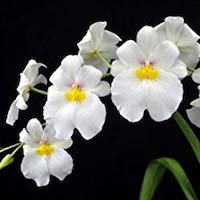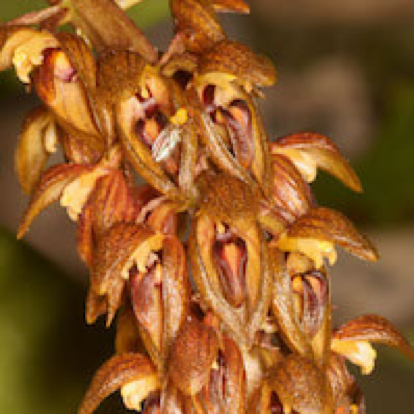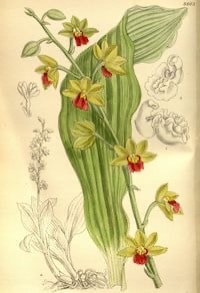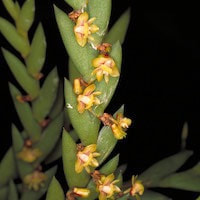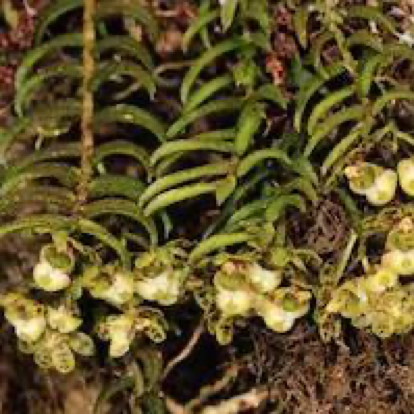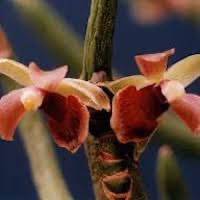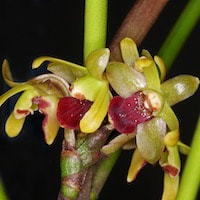Elevate Your Senses with Floral 3 Fragrance Oil
The perfume composition incorporates scented notes from a variety of orchids and other fragrant ingredients. Among the native Singaporean orchids, the Bulbophyllum Vaginatum stands out for its unique fragrance, while the Miltoniopsis Santanaei, used in the Floral 3 (Women) perfume workshop at Scentopia, emits a delightful rose-like scent. Moving on to therapeutic orchids, the Bulbophyllum careyanum contributes to herbal remedies for treating burns, while the Calanthe tricarinata Lindl. is utilized in traditional medicine to address wounds, eczema, jaundice, and typhoid, promoting blood circulation and muscle relaxation. The Dendrobium indivisum (Blume) Miq. is known for its headache-relieving properties, while the Gastrochilus distichus finds application in the treatment of mastitis.
The perfume also incorporates scented notes from the Luisia orchids. The Luisia morsei Rolfe, known by different Chinese names, holds significance in Traditional Chinese Medicine (TCM), where it is employed to enhance the movement of "wind," boost yang elements, and alleviate vomiting. It also finds use in treating conditions like infantile paralysis, rheumatism, malaria, and hypertension. Similarly, the Luisia tristis (G.Forst.) Hook. f., found in various regions including India, Sri Lanka, and Thailand, is valued for its medicinal properties. It is used in the preparation of oils, pastes, and plasters to address fractures, abscesses, tumors, and chronic wounds.
Completing the fragrance composition, other scented ingredients such as geranium, forget-me-not, encian, gerbera, lotus, bellflower, angel's trumpet, edelweiss, magnolia, and snowflower contribute their unique aromas. Together, these various scented notes blend harmoniously to create the overall fragrance of the perfume, offering a diverse olfactory experience.
The perfume also incorporates scented notes from the Luisia orchids. The Luisia morsei Rolfe, known by different Chinese names, holds significance in Traditional Chinese Medicine (TCM), where it is employed to enhance the movement of "wind," boost yang elements, and alleviate vomiting. It also finds use in treating conditions like infantile paralysis, rheumatism, malaria, and hypertension. Similarly, the Luisia tristis (G.Forst.) Hook. f., found in various regions including India, Sri Lanka, and Thailand, is valued for its medicinal properties. It is used in the preparation of oils, pastes, and plasters to address fractures, abscesses, tumors, and chronic wounds.
Completing the fragrance composition, other scented ingredients such as geranium, forget-me-not, encian, gerbera, lotus, bellflower, angel's trumpet, edelweiss, magnolia, and snowflower contribute their unique aromas. Together, these various scented notes blend harmoniously to create the overall fragrance of the perfume, offering a diverse olfactory experience.
Download the guided mediation that works best with this Orchid fragrance oil
| women_floral_essential_oil_orchi_00003.mp3 | |
| File Size: | 230478 kb |
| File Type: | mp3 |
The Power of Orchids Unleashed
Contains Scented Notes of following in various proportions:
Native Singaporean Orchid notes: Bulbophyllum Vaginatum
|
Miltoniopsis Santanaei - Used in Floral 3 (Women) for Team building Perfume workshop
Miltoniopsis Santanaei is a notable ingredient used in the Floral 3 (Women) perfume workshop for team building. In the past, miltoniopsis orchids enjoyed immense popularity among growers, as evidenced by the abundance of literature, drawings, and photographs showcasing their magnificent plants adorned with flowers. This delightful orchid variety is known for its compact size and carries a delightful scent reminiscent of roses. Many hybrid variations of miltoniopsis also possess this characteristic fragrance, adding to their appeal in the world of perfumery. |
Therapeutic Orchid notes:
|
Bulbophyllum careyanum
Bulbophyllum careyanum is an orchid species characterized by its conical pseudobulb, which emits a musky smell. It has a single elliptic leaf at the top, and the inflorescence emerges from the base of the pseudobulb. This orchid is found in various regions including Nepal, Bhutan, Myanmar, Thailand, and Vietnam. Bulbophyllum careyanum is known for its unique and distinctive scent. The fragrance of this orchid can vary, but it is often described as a combination of musky, earthy, and slightly sweet notes. Some may find the scent of Bulbophyllum careyanum to be intense or even unpleasant due to its foul-smelling pseudobulb. However, as fragrance preferences are subjective, there are individuals who appreciate the intriguing and exotic aroma that this orchid emits. In traditional herbal usage, poultices made from the pseudobulbs and leaves of Bulbophyllum careyanum are utilized for treating burns on the skin. The therapeutic properties of this orchid make it a valuable ingredient in natural remedies for skin ailments. |
|
Chinese name: Sanlengxiaji Lan (triangular prism prawn spine orchid)
Chinese medicinal name: Jiuzilianhuancao (nine united sons flowering herb) This name also refers to Calanthe discolor; Roulianhuan Bulbophyllum careyanum, known as Sanlengxiaji Lan in Chinese, is a species of orchid that is valued for its medicinal properties. In traditional Chinese medicine (TCM), it is referred to as Jiuzilianhuancao, which translates to "nine united sons flowering herb." It is worth noting that this name is also used for another orchid species, Calanthe discolor. Bulbophyllum careyanum can be found in various regions of China, including Shanxi, Hubei, Sichuan, Yunnan, Guangxi, Guizhou, and Xizang. In Nepal, the leaves of this orchid are used to create a paste that is applied topically to treat wounds and eczema. The leaves and pseudobulbs of the plant are highly regarded as aphrodisiacs in Nepalese traditional medicine. In Uttarakhand, located in the western Himalayas, the roots and leaves of Bulbophyllum careyanum are used to treat jaundice and typhoid. In Chinese herbal medicine, the root of the plant is utilized to stimulate blood circulation, relax muscles and joints, relieve wind-related discomfort, and stop bleeding. It is employed in the treatment of various conditions, including stomachaches, arthritis, lumbar muscle degeneration, and traumatic injuries. The medicinal properties of Bulbophyllum careyanum have been recognized and utilized in traditional healing practices for their potential therapeutic benefits. However, it is important to consult with a qualified healthcare professional or practitioner of traditional medicine for appropriate guidance and dosage when using herbal remedies. |
|
Thai Name: Kang pla
Kang Pla, also known as Dendrobium kangplaense, is a small species of Dendrobium orchid found in Thailand, Laos, Vietnam, Malaysia, and Indonesia. Despite being a free-flowering orchid, it is not highly valued for horticultural purposes due to the relatively small size of its flowers. In traditional Thai medicine, Kang Pla has been utilized for its potential medicinal properties. The whole plant is used as a herbal remedy to treat headaches. It is believed that certain compounds or properties within the orchid may help alleviate headache symptoms, although specific mechanisms or active constituents have not been extensively studied or identified. It's important to note that traditional herbal remedies should be approached with caution, and it's advisable to consult with a qualified healthcare professional or practitioner of traditional medicine for appropriate usage and guidance. Additionally, further scientific research is needed to fully understand the potential medicinal properties and safety profile of Kang Pla orchid in treating headaches or other conditions. |
|
Gastrochilus distichus (Lindl.) Kuntze syn. Saccolabium distichum Lindl
Chinese name: Lieyepenju Lan (leaves in a row, pot distance orchid) Chinese medicinal name: Fenghuangmao Gastrochilus distichus, also known as Saccolabium distichum, is an orchid species found in southeast Tibet, western Yunnan, Sikkim, Bhutan, and Nepal. In Chinese, it is referred to as "Lieyepenju Lan," which translates to "leaves in a row, pot distance orchid," and it has a Chinese medicinal name of "Fenghuangmao." Regarding its phytochemistry, Gastrochilus distichus has been found to contain alkaloids, although specific details about the alkaloid compounds present in this orchid species are not readily available. In traditional medicine, Gastrochilus distichus has been used for its potential therapeutic properties. It is employed in the treatment of mastitis, an inflammatory condition of the breast tissue that can occur in lactating women. The specific parts of the plant and the methods of preparation and administration may vary within traditional medicinal practices. It's important to note that while traditional usage of Gastrochilus distichus suggests potential therapeutic benefits, scientific studies exploring its efficacy, safety, and mechanisms of action are limited. Therefore, it is advisable to consult with a qualified healthcare professional or practitioner of traditional medicine for appropriate usage and guidance. Furthermore, as with any herbal remedy, it is crucial to exercise caution, especially if you have specific health conditions, are taking medications, or are pregnant or breastfeeding. |
|
Chinese names: Dayangjiao (big goat horn), Chaizigu (hairpin strand), Jinhuancao (gold ring grass), Shucong (tree onion).
Chinese medicinal names: Chaizigu (hairpin strand); Jinchagu (gold hairpin section); Sanshi Gen (30 root); Songjisheng (pine para- site); Chongjisheng (worm parasite) Haibanhu (sea strip tiger) Tanxiangxian (sandlewood thread) Longxucao (dragon beard grass) The orchid species referred to as Dayangjiao (big goat horn), Chaizigu (hairpin strand), Jinhuancao (gold ring grass), and Shucong (tree onion) in Chinese, has several medicinal names including Chaizigu (hairpin strand), Jinchagu (gold hairpin section), Sanshi Gen (30 root), Songjisheng (pine parasite), Chongjisheng (worm parasite), Haibanhu (sea strip tiger), Tanxiangxian (sandalwood thread), and Longxucao (dragon beard grass). This epiphytic orchid is primarily found in hilly forests in southern China, specifically in regions such as Hainan, Guangxi, Guizhou, and Yunnan. It is also present in other countries including Japan, Vietnam, Laos, and Thailand. In Traditional Chinese Medicine (TCM), this orchid is valued for its various medicinal properties. According to TCM, the whole plant is believed to promote the movement of "wind" in the body, boost yang elements, and alleviate vomiting. It is also known for its detoxifying properties and its ability to remove gas and dampness from the body. In Taiwan, it is used for the treatment of infantile paralysis, rheumatism, malaria, edema, hypertension, and for poison removal. Additionally, it is thought to have insecticidal properties. It's important to note that while this orchid has a long history of traditional usage, scientific studies on its medicinal properties and safety are limited. As with any herbal remedy, it is advisable to consult with a qualified healthcare professional or practitioner of Traditional Chinese Medicine for appropriate usage and guidance. |
|
Luisia tristis (G.Forst.) Hook. f. Syn. Luisia teretifolia Gaudich., Luisia zeylandica Lindl.
Indian and Bangladeshi name: Koira Nepalese names: Bori jhaar, Kuwaa ko keraa Sri Lankan name: Muwa kiriya (Stems like deer horns), soma valli (in Sanskrit) Thai name: Kluai nam thai Chinese medicinal name: Jinchaigu Luisia tristis, also known as Luisia teretifolia and Luisia zeylandica, is a species of orchid with various regional names. In India and Bangladesh, it is referred to as Koira, while in Nepal, it is known as Bori jhaar and Kuwaa ko keraa. In Sri Lanka, it is called Muwa kiriya (Stems like deer horns) and soma valli in Sanskrit. The Thai name for this orchid is Kluai nam thai, and it is also given the Chinese medicinal name Jinchaigu. This orchid species is distributed across a wide range, from Bhutan and the Sikkim Himalayas to south India and Sri Lanka. It can also be found in Bengal, Myanmar, the Andaman Islands, Thailand, Malaysia, the Philippines, and New Caledonia. Luisia tristis typically grows at low elevations. Regarding its phytochemistry, Luisia tristis contains a small amount of alkaloid compounds. In traditional herbal usage, this orchid is valued for its medicinal properties. In Sri Lankan Ayurvedic medicine, it is used in the preparation of medicinal oils for the treatment of fractures. In Uttar Pradesh, a paste made from crushed plants is applied to boils, abscesses, and tumors. In Nepal, an emollient made from the plant is used for abscesses and burns, while the juice from its leaves is used to treat chronic wounds and eliminate worms. In Bangladesh, Nepal, and Karnataka (India), the stems are employed to treat boils, burns, and fractures. A paste made from the dried plant, combined with turmeric and ginger, is taken orally to treat jaundice for ten days. In addition, the root extract is used for myalgia and to alleviate diarrhea in cattle. Local communities in Bisamkatak, Orissa, refer to the plant as koira and use a paste made from the entire plant, along with egg white, turmeric, and calcium, as a plaster to set fractures on fractured limbs, which is then bound with a bandage. Although it is listed as a herbal remedy called Jinchaigu in Zhongyao Bencao, it is important to note that L. zeylandica, which is a quarter of L. tristis, does not naturally occur in China. Instead, it is imported from India and Myanmar. In Yunnan, China, this orchid is used to treat conditions such as heatiness, toxin elimination, malaria, pruritus, sore throat, otitis media, and food poisoning. |
Other scent note
Geranium, Forget-me-not, Encian, Gerbera, Lotus, Bell flower, Angel’s trumpet , Edelweiss, Magnolia, Snow flower
Scentopia Library Reference ingredient
Jasmin - Check details at Scentopia's scent library
Join Scentopia's wonderful orchid scent crafting, fragrance tour, bridal shower or corporate team building which includes perfume making onsite and offsite, beach activities and more. We also serve primary school learning journey, secondary students and pupil on industrial excursions. Know more about our orchids perfume bar or therapeutic orchid scents and other wellness aromas. Conatct Perfume workshop or book a scent crafting session here.
